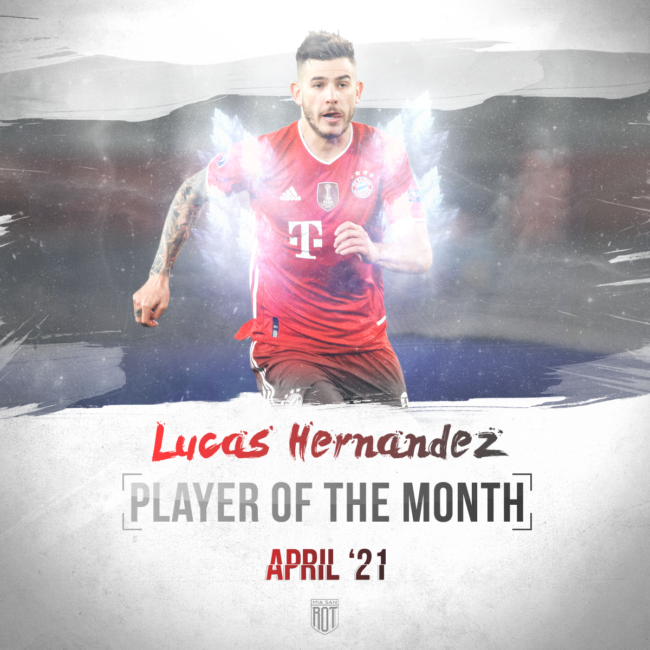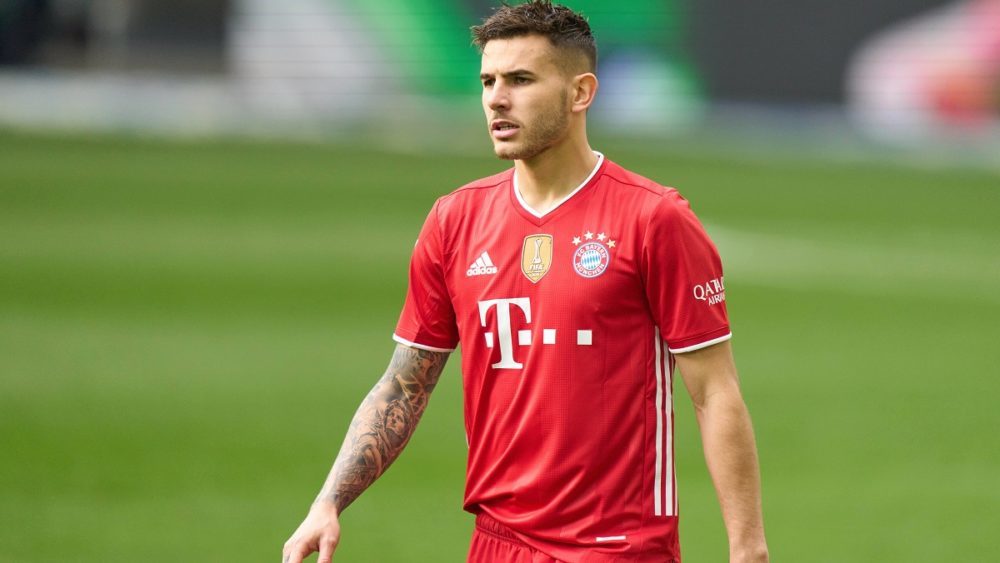Player of the month April: Lucas Hernández
The 2020/21 season has seen slight improvements for Hernández. Currently, he can boast 34 appearances, in 48% of which he featured in the starting eleven. For comparison, these are the players he competes with in the centre-back and left-back positions:
- David Alaba: 42 appearances, 87% starting rate
- Jérôme Boateng: 36 appearances, 84 % starting rate
- Niklas Süle: 32 appearances, 48 % starting rate
- Alphonso Davies: 32 appearances, 61 % starting rate
It should be taken into account that Hernández benefited from Alphonso Davies’s lengthy injury lay-off in the first half of the season. The season so far can therefore be described as a mixed affair at best. It was often suggested that Hansi Flick must have lacked confidence in him, otherwise his role as a supplementary player often seemed incomprehensible. At times, it seemed as if Hernández could deliver world-class performances – and yet he would not start in the next game. April 2021 ultimately disproved this theory. In five of April’s seven competitive matches for Bayern, Hernández ran out from the beginning, played all these games over the full distance and, with increasing playing routine and growing confidence, was finally able to show his abilities and quality. He missed the other two games due to injury.

His good performances culminated in the Champions League quarter-final second leg against PSG, where he was one of the most conspicuous players on the pitch. Fast, physically strong, present in the duels, aggressive but fair. Above all, one strength came to the fore: the ability to isolate opponents in order to then capitalize on his strengths in defensive one-on-one situations. In this way, he prevented potentially dangerous counterattacking situations on several occasions.
What are Hernández major strengths?
Hernández has his strengths especially in the defensive part of a center-back’s extensive job profile. Physically, his stand out features are his quick acceleration and considerable pace. Cognitively, his good pre-orientation and perception as well as his good anticipation of what is likely to happen next help him immensely in his positional play. In addition, he showed considerable mental skills in the two Champions League matches in April: concentration, focus and an unconditional desire to win paired with an above-average aggressive style of play. Hernández has learned how to use this aggressiveness to good effect (at times his tackling seemed rather impetuous in the past, but his progress in this area is obvious). In particular, his ability to push up with purpose when the opponent is attacking has added a new element to FC Bayern’s otherwise rather wait-and-see back four – if used sensibly. Added to this is his versatility. According to Hernández himself, he “doesn’t care” whether he is used in the center or on the left.
What does he still have to work on?
Due to the offensive style of play under Flick, the demands on center-backs at FC Bayern are not only defensive ones. On the contrary, sometimes instead of defending there ist an even greater focus on their abilities as build-up players: passing accuracy, composure on the ball, vertical play. Especially the ability to play through the opponent’s lines requires good decision-making, high precision and variability in passing over short and long distances as well as a willingness to take risks.
Hernández has all these skills in varying degrees. However, he went through a completely different school of how to play in central defense. Hernández played for Atlético Madrid for 12 years before joining FC Bayern. Especially under Diego Simeone, who has been Atlético’s first team coach since 2011, Hernández was asked to play in a deep defense in a 4-4-2 system, in which little emphasis was placed on possession (at least in the early years) and defensive stability was paramount.
The requirements at Bayern have turned 180°, especially under Flick. Defending there consists of an extremely high back four that dynamically mutates into a back three or even two and in which the centre-backs play a leading role in build-up play.
What has this meant for Hernández? More touches, different demands in positioning in build-up play (e.g. playing on the half-turn, anticipating and creating favourable passing angles) and, most of all, high passing quality. In many of these areas, Hernández still has to improve. Fortunately, in April he showed that he seems to be equal to this challenge. For example, he demonstrated promising dribbling skills, although he still gets stopped a little too often because he misses the right moment for a pass.
But he can also improve in two aspects without the ball: First of all, there is his timing. When he pushes forward out of the back line to challenge an opponent, he has to win this challenge to avoid affording the opponent a hole in defense to play through. Mind you, this is criticism at a very high level. In many cases, Hernández is able to anticipate attacks early and defend. The next step will be to become more consistent in making the right decision between holding the line and pushing out. Another point is the communication on the pitch. The language barrier certainly means that he is not a natural director, but the longer he plays at FC Bayern, the more he will have to take responsibility and give commands.
What could change for Hernández next season?
It will be interesting to observe what role Hernández will have under Nagelsmann in the coming season. Nagelsmann places more emphasis on defensive stability than Flick while still focusing on the offense. At RB Leipzig, he has found a good balance in this respect. Whether he can also succeed at Bayern will probably depend on players like Lucas Hernández, among others.
Hernández’s drive, basic speed and ability to anticipate can be great advantages in playing a high defensive line. With his interceptions, won running duels and advantages in one-on-one situations, he has bailed out his team in counter-attacks several times this season.
The situation that the two deserving center-backs David Alaba and Jérôme Boateng will leave the club at the end of the season is certainly also an advantage for Hernández. With Dayot Upamecano, another center-back will strengthen the ranks, but the chances are good that Hernández will get ample opportunities to play. That he has only been sparingly used in the current season has not always been easy to explain, but it is partly understandable when looking at the details. Despite the high defensive vulnerability, Flick may have relied on his defensive leader David Alaba, who – like Boateng – brings the skills in build-up play that Hernández has still been lacking in some areas.
Hernández’s recent appearances give hope and courage that he could develop into an important player in FC Bayern’s structure.
The transfer fee needs to be taken into account
Hernández was one of the most expensive transfers in Bundesliga history and Bayern’s record purchase. As already mentioned at the beginning, the transfer fee of €80 million has hung around his neck since the transfer became public knowledge. This burden should not be underestimated, especially since Hernández was injured for a long time right at the beginning of his first season. He was slowed down by external factors beyond his control. These made it impossible for him to fulfil the expectations and hopes placed in him. Leroy Sané was in a similar situation at the beginning of this season.
One reason for exaggerated expectations in the wake of high transfer fees could be that with a growing investment size, the players’ performance is expected to disproportionately increase along with it. An absurd idea. At the same time, players with an elevated public profile are subject to special observation by fans, the media and probably also coaches and fellow players due to the amount of money their club has spent on them. It is logical to assume that with the growing attention each of the player’s actions is that much more carefully observed and evaluated. On top of that comes the confirmation bias (“I only see what meets my expectations”), which in the case of Hernández leads to this:
Hernández is announced as a record transfer. Up to that point, laying out so much money for a defender had been unheard of. As a result, there are extremely high expectations of his performance. He plays solidly in the first few games, but not more than that. ‘Solid’ in light of the expectations translates into: disappointing. So what is the lasting impression? “Hernández, the record transfer who is not worth his money.” Then a long injury break follows. After his return, the observers evaluate each action against the background of their previously formed attitude and expectations. They (involuntarily) filter out what does not correspond to their previously formed image: “I believe Hernández is an overpriced purchase and that he is not a world-class player. I therefore particularly notice the actions that confirm this image.”
Conclusion
In April 2021, it became clear that Hernández was getting more comfortable in his role in Bayern’s system under Flick. He has made strides in extinguishing his image as an overpriced newcomer and establishing himself as a regular player. He seems willing to develop and able to confront adverse circumstances. His improvements are clearly visible and suggest that he is working hard on himself. His initially wild tackling has turned into mostly very clever and fair tackling. He now dares to play more risky diagonal switches of the play instead of going for the safety pass to the next man. He also plays many more vertical passes into the center and makes successful dribbles past his opponents. His mentality deserves special mention. It is not a matter of course that a player after one and a half rather sobering seasons is able to deliver concentrated, focused performances characterized by desire without noticeable frustration – whether over 90 minutes or in short appearances. After the Champions League second leg against PSG one could say: Yes, Hernández has the Bayern gene.









